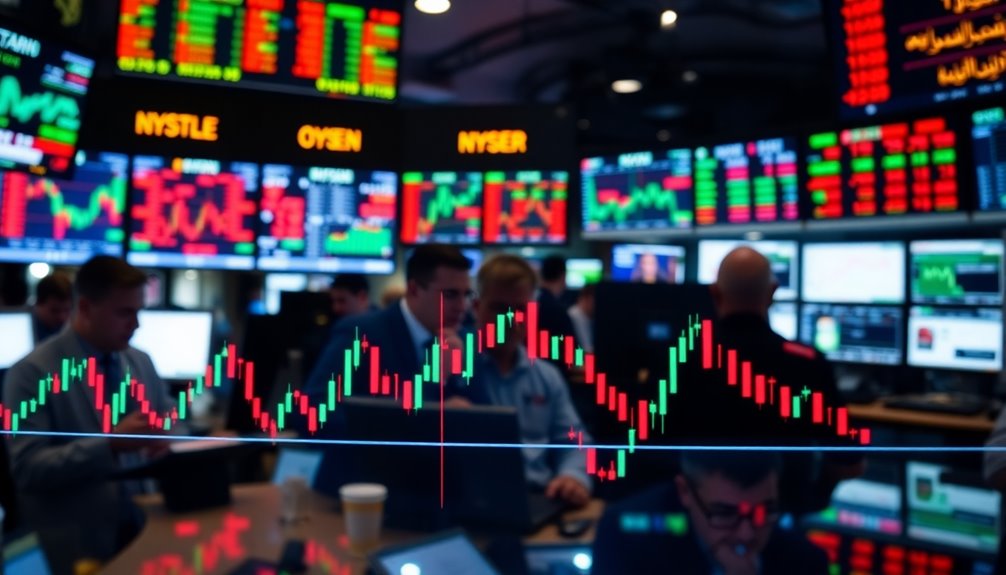Open interest indicates the total number of outstanding contracts in the derivatives market. It reflects market activity and liquidity, changing daily as traders open or close positions. When open interest rises, it suggests new money is entering the market, signaling strong trends and trader interest. Conversely, decreasing open interest may hint at market liquidation or potential reversals. Keep an eye on open interest alongside trading volume to gauge market sentiment more effectively. Understanding how these factors interplay can give you a deeper insight into market dynamics, leading to more informed trading decisions as you explore further.
Key Takeaways
- Open interest reflects total outstanding contracts in the derivatives market, indicating market activity and liquidity.
- An increase in open interest suggests new money entering the market and growing trader interest.
- A decline in open interest may signal market liquidation, potential reversals, or reduced participation.
- Rising open interest alongside increasing prices typically indicates bullish sentiment among traders.
- Monitoring open interest with trading volume provides deeper insights into market trends and trader confidence.
Core Concept of Open Interest

Open interest is a crucial indicator in the derivatives market, representing the total number of outstanding contracts that haven't been settled. It reflects market activity and liquidity, changing daily based on trader actions.
When you open new positions, open interest increases; when you close them, it decreases. High open interest often signals strong trends and sustained trader interest, indicating a potential bullish trend in futures contracts.
It's important to differentiate open interest from trading volume, as volume measures contracts traded within a period, while open interest shows active contracts.
Defining Open Interest Significance

Understanding the significance of open interest is essential for navigating the derivatives market effectively. Open interest represents the total number of outstanding derivative contracts that remain unsettled, providing insight into market liquidity and activity levels.
When you see increasing open interest, it often indicates new money entering the market, suggesting sustained market trends. Conversely, decreasing open interest may signal market liquidation, hinting at potential reversals.
This measure also reflects trader sentiment; high open interest can point to strong bullish or bearish trends without revealing specific directions. By monitoring open interest alongside trading volume, you can better assess market interest and anticipate price movements, making it a vital tool for informed trading decisions.
Mechanics of Open Interest

The mechanics of open interest play a pivotal role in understanding market dynamics. Open interest represents the total number of outstanding derivative contracts, like options or futures, that are still active.
You calculate it by adding new positions and subtracting closed contracts, reflecting daily market activity. When new positions are initiated, open interest increases, signaling growing trader interest and liquidity.
Conversely, when existing positions are closed, it decreases, indicating a potential decline in market participation.
Unlike trading volume, which measures contracts traded over a specific period, open interest tracks the total open positions at day's end.
Changes in open interest can provide insights into market sentiment, helping you gauge the overall health of the trading environment.
Pros and Cons Analysis

While high open interest can indicate strong market trends and liquidity, it's essential to weigh both the advantages and drawbacks of this metric.
On the pro side, rising open interest often signals new money entering the market, which suggests bullish conditions and the potential for continued price action. Additionally, robust liquidity facilitates smoother transactions, attracting more traders.
However, open interest doesn't specify market direction, meaning both bullish and bearish sentiment can coexist. Declining open interest during a price drop may indicate liquidations and signal bearish sentiment, hinting at possible market reversals.
Open Interest Versus Market Sentiment

As open interest shifts, it reveals valuable insights into market sentiment, helping you gauge trader confidence.
Rising open interest often indicates bullish sentiment, especially when combined with increasing prices, signaling new money coming into the market. Conversely, declining open interest might suggest bearish sentiment, reflecting uncertainty or traders exiting positions during price drops.
You can observe price direction closely; increasing open interest alongside rising prices points to strong market trends, while falling prices with rising open interest often indicate growing bearish pressure.
Additionally, low open interest at market peaks may hint at a potential reversal, while low open interest at market bottoms could suggest a recovery is on the horizon.
Understanding these dynamics can enhance your trading decisions.
Market Volatility Implications

Understanding market volatility implications requires a close look at open interest, which often acts as a barometer for trader activity. High open interest typically indicates increased trader interest and potential price fluctuations, signaling a busy market environment.
When you see rising open interest alongside price movements, it suggests sustained market trends. Conversely, low open interest may point to decreased liquidity and wider bid-ask spreads, leading to more volatility as executing trades becomes challenging.
Rapid shifts in open interest during volatile periods can reveal possible reversals or continuations in market trends, making it essential for your trading strategies. Keeping an eye on these dynamics helps you navigate the complexities of market volatility effectively.
Recent Market Open Interest Patterns

Market volatility often influences trader behavior, and recent open interest patterns highlight this connection across various asset classes.
In the S&P 500 options market, open interest increases have correlated with rising volatility, indicating more traders are hedging against market fluctuations.
Meanwhile, the Bitcoin options market saw open interest surge to an all-time high in October 2023, reflecting growing confidence among traders.
In crude oil futures, open interest rose over 15% in September, showcasing bullish sentiment due to anticipated supply issues.
Additionally, large speculators boosted their long positions in gold options, signaling potential bullish trends.
Lastly, Eurodollar futures displayed steady open interest increases as traders prepare for changes in interest rates amid economic uncertainty.
Utilize Open Interest Trends

Utilizing open interest trends can provide valuable insights into market dynamics and trader sentiment. When open interest rises during uptrends, it typically reflects bullish sentiment as new money enters the market.
Conversely, if prices increase while open interest declines, it might suggest short sellers are covering, indicating a potential bearish reversal. By monitoring open interest alongside price movements, you can identify possible market tops or bottoms, as high open interest at peaks often signals impending price declines.
Furthermore, increasing open interest with rising trading volume indicates strong market participation and liquidity, reinforcing the reliability of current price trends. Resources like the CME Group allow you to track daily changes in open interest, helping you gauge market sentiment effectively.
Frequently Asked Questions
Is Open Interest Bullish or Bearish?
Open interest can be both bullish and bearish, depending on market conditions.
If you see rising prices alongside increasing open interest, it usually signals new money entering the market, indicating a bullish trend.
However, if prices fall while open interest rises, it suggests traders might be short-selling, hinting at bearish sentiment.
Is Higher Open Interest Better?
Higher open interest isn't inherently better; it depends on the market context.
It often signals increased activity and liquidity, which can be positive. However, you need to consider what's driving that open interest.
If it's due to strong buying, it might indicate confidence in price increases. Conversely, if high open interest arises in a bearish trend, it could suggest heavy short-selling.
Always weigh open interest alongside other indicators to get a complete picture.
What Can Open Interest Tell You?
Open interest can tell you a lot about market dynamics. When you see increasing open interest, it often means new money's entering the market, suggesting a continuation of trends.
Conversely, if open interest drops, it might indicate liquidations or potential reversals.
What if Call Oi Is High?
If call open interest is high, it usually signals strong bullish sentiment among traders.
You might see increased market activity, making it easier for you to enter or exit positions without causing significant price changes. This could mean new money is entering, potentially supporting an upward trend.
However, if the underlying asset's price is dropping while call OI stays high, it might indicate that traders are holding out for a price rebound.
Conclusion
In summary, understanding open interest can significantly enhance your trading strategy. It offers valuable insights into market activity and can help you gauge the strength of trends. By analyzing open interest trends alongside market sentiment and volatility, you can make more informed decisions. Keep an eye on recent patterns, and use this knowledge to your advantage. Embracing open interest as part of your toolkit will empower you to navigate the markets with greater confidence.









